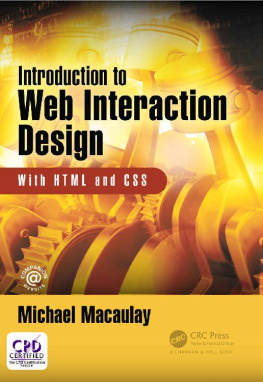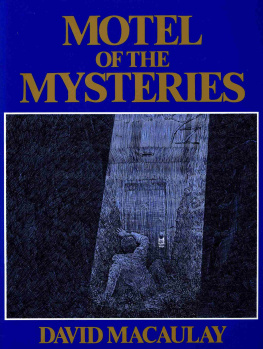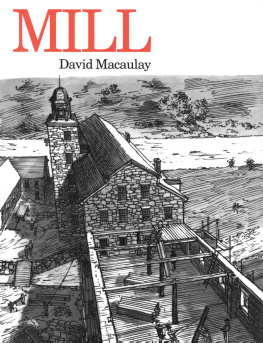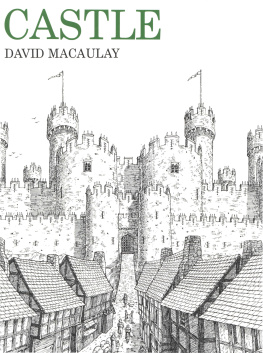Introduction to Web
Interaction Design
With HTML and CSS
Introduction to Web
Interaction Design
With HTML and CSS
Michael Macaulay

CRC Press
Taylor & Francis Group
6000 Broken Sound Parkway NW, Suite 300
Boca Raton, FL 33487-2742
2018 by Taylor & Francis Group, LLC
CRC Press is an imprint of Taylor & Francis Group, an Informa business
No claim to original U.S. Government works
Printed on acid-free paper
Version Date: 20170407
International Standard Book Number-13: 978-1-1389-1185-7 (Paperback)
This book contains information obtained from authentic and highly regarded sources. Reasonable efforts have been made to publish reliable data and information, but the author and publisher cannot assume responsibility for the validity of all materials or the consequences of their use. The authors and publishers have attempted to trace the copyright holders of all material reproduced in this publication and apologize to copyright holders if permission to publish in this form has not been obtained. If any copyright material has not been acknowledged please write and let us know so we may rectify in any future reprint.
Except as permitted under U.S. Copyright Law, no part of this book may be reprinted, reproduced, transmitted, or utilized in any form by any electronic, mechanical, or other means, now known or hereafter invented, including photocopying, microfilming, and recording, or in any information storage or retrieval system, without written permission from the publishers.
For permission to photocopy or use material electronically from this work, please access www.copyright.com (http://www.copyright.com/) or contact the Copyright Clearance Center, Inc. (CCC), 222 Rosewood Drive, Danvers, MA 01923, 978-750-8400. CCC is a not-for-profit organization that provides licenses and registration for a variety of users. For organizations that have been granted a photocopy license by the CCC, a separate system of payment has been arranged.
Trademark Notice: Registered trademark of products or corporate names are used only for explanation and identification without intent to infringe.
Library of Congress Cataloging.in.Publication Data
Names: Macaulay, Michael, author.
Title: Introduction to Web interaction design : with HTML and CSS / Michael
Macaulay.
Description: Boca Raton, FL : CRC Press, [2017] | Includes bibliographical
references.
Identifiers: LCCN 2016031177| ISBN 9781138911857 (pbk. : acid-free paper) |
ISBN 9781317432814 (web pdf) | ISBN 9781317432807 (epub) | ISBN
9781317432791 (mobipocket/Kindle) | ISBN 9781315692333 (master)
Subjects: LCSH: Web sites--Design. | Web site development. | Human-computer
interaction. | Computer software--Human factors.
Classification: LCC TK5105.888 .M25 2017 | DDC 006.7--dc23
LC record available at https://lccn.loc.gov/2016031177
Visit the Taylor & Francis Web site at
http://www.taylorandfrancis.com
and the CRC Press Web site at
http://www.crcpress.com
Contents
4.4.1.1 ,
, , and, , and 5.4.3.1 ... 5.4.9.1 .../ ... 6.3.2 ...
6.3.4 ... and ...
About This Book
Much of what is in this book can be found on the Web in one form or another, but not together in one place and not in as concise and structured manner that enhances learning as in this book. The book introduces the basic Web technologies, design principles and processes, and management practices used in Web design as well as how to use all of them in the designing and building of a working interactive website that is easy to use and accessible to those with disability. There are ample examples on how all commonly used HTML elements, attributes, and CSS properties are used and design guidelines about best practices. There are also ample theoretical and practical exercises to ensure continued involvement and interest of the reader in the topics introduced, and all that is required to do the exercises or implement the examples are a Web browser and a text editor such as Notepad on Windows, TextEdit on Mac, or Gedit on Linux. For further reading and newer materials, Web addresses for the relevant sources are also provided to enable readers to check the sources for updated materials.
A companion website is available at www.routledge.com/cw/Macaulay which contains code snippets, interactive exercises and further reading and resources.
Target Audience
This book is intended for:
- Those with no prior knowledge of Web design who wish to learn how to design and build websites of professional quality.
- Someone who already knows how to design and build a website using Web tools, such as content management systems, e-commerce platforms, or blogging software, that allow him or her to build websites without the knowledge of coding, but wants more control over the design offered.
Structure of This Book
This book is divided into four parts: HTML (HyperText Markup Language), CSS (Cascading Style Sheets), Web Design Principles and Practices, and Web Development Process.
Part I: HTML
This part presents chapters that introduce the functionalities supported by HTML. It shows how to use them to add various elements to a page, including text, links, lists, tables, forms, images, audio, video, and animation. It also shows how to use them to structure the content of a Web page, such as into headings, sections, paragraphs, and quotations.
Part II: CSS
This part explains the role of CSS in the styling and layout of Web pages, and the chapters introduce the functionalities that CSS supports such as the control of the font, size and style of text, color of elements, arrangement of elements, and the use of images for background.
Part III: Web Design Principles and Practices
This part comprises chapters on the fundamental principles of visual design and their applications to Web design. It discusses how these principles can enhance the aesthetics of a design, and also the role of aesthetics in user-satisfaction as well as in how usable users judge a website to be and its credibility; all of which play important roles in user experience and acceptance.
Part IV: Web Development Process
This part presents chapters that deal with the stages of Web design and development and how they are managed to ensure the smooth running and timely completion of a project. An extra chapter is also included that presents various useful practical information, including how scripts are used with CSS to realize more advanced interactive designs, how various other common Web-programming languages are used with HTML, and how to set up a Web server on a home computer to try them out.
Michael Macaulay, PhD, is a freelance educator, developer, and user-experience designer and evaluator. Formerly, he was a senior lecturer and course director for multimedia courses at London South Bank University, United Kingdom. He earned his PhD in 2000 in the effects of humancomputer interaction and multimedia in learning from Loughborough University, United Kingdom. In the past, he had also been a computer systems administrator, computer systems programmer and analyst, and desktop publisher.
It is useful to know a little about the technical aspects of the Internet and the Web in order to better understand the various terminologies used in this book and also how what you produce will generally work. If you find that something is too technical in this chapter, you can skip it and then come back to it when you feel more comfortable with the subject or feel the need to know it.














